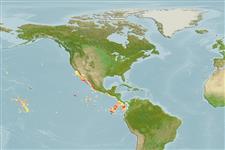Klassifizierung / Names
Namen | Synonyme | Catalog of Fishes(Gattung, Arten) | ITIS | CoL | WoRMS | Cloffa
Environment: milieu / climate zone / depth range / distribution range
Ökologie
seewasser bathydemersal; tiefenbereich 0 - 2000 m (Ref. 43481). Deep-water
Eastern Central Pacific: off central Baja California, Mexico.
Size / Gewicht / Alter
Maturity: Lm ? range ? - ? cm
Max length : 7.1 cm TL Männchen/unbestimmt; (Ref. 43481)
Kurzbeschreibung
Bestimmungsschlüssel | Morphologie | Morphometrie
Rückenflossenweichstrahlen (insgesamt) : 38; Wirbelzahl: 43. Body including peritoneum and all internal organs entirely pale. Coronal pore present. Mouth slightly oblique, 20-25° to horizontal; premaxilla reaching behind posterior margin of eye. Eye approximately 18% HL. Gill rakers paired, spinule plate at tip longitudinally oval, spinules with rounded tips; in a converging double row of 8-9 spinules each. Abdomen short, preanal fin length 35% SL (Ref. 43481).
Life cycle and mating behavior
Maturities | Fortpflanzung | Spawnings | Egg(s) | Fecundities | Larven
Chernova, N.V. and D.L. Stein, 2002. Ten new species of Psednos (Pisces, Scorpaeniformes: Liparidae) from the Pacific and North Atlantic oceans. Copeia 2002(3):755-778. (Ref. 43481)
IUCN Rote Liste Status (Ref. 130435)
Bedrohung für Menschen
Harmless
Nutzung durch Menschen
Tools
Zusatzinformationen
Download XML
Internet Quellen
Estimates based on models
Preferred temperature (Ref.
123201): 5.2 - 11.5, mean 7.9 °C (based on 57 cells).
Phylogenetic diversity index (Ref.
82804): PD
50 = 0.5000 [Uniqueness, from 0.5 = low to 2.0 = high].
Bayesian length-weight: a=0.00525 (0.00237 - 0.01161), b=3.15 (2.96 - 3.34), in cm total length, based on LWR estimates for this (Sub)family-body shape (Ref.
93245).
Trophic level (Ref.
69278): 3.3 ±0.5 se; based on size and trophs of closest relatives
Widerstandsfähigkeit (Ref.
120179): hoch, Verdopplung der Population dauert weniger als 15 Monate. (Preliminary K or Fecundity.).
Fishing Vulnerability (Ref.
59153): Low vulnerability (10 of 100).
